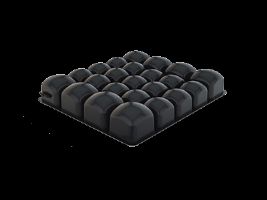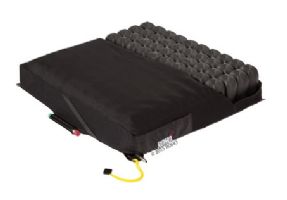 Written by Susan Griffitts, MSN, RN, FCN
Written by Susan Griffitts, MSN, RN, FCN
Each year more than 2.5 million people in the United States develop a pressure ulcer. These lesions are not just painful for the patients but result in increased healthcare costs as well as medical complexity. Prevention is key with proper positioning, patient education, and postural support at the forefront.
ROHO cushions are specially designed wheelchair cushions that are molded to fit your body and every type of wheelchair. They provide individuals with skin integrity issues an optimal environment to efficiently distribute pressure, minimize shear forces and prevent skin breakdown. With many postulating that pressure injuries are a widely preventable condition and minimal change in pressure injury incidence over recent years, it’s time to take control.
Follow along as we review the unique specifications and benefits of ROHO cushions and how to choose the best one for you.
 | ROHO Mosaic Air Wheelchair Cushion View Product |
Recommended: ROHO Mosaic Air Wheelchair Cushion
ROHO Cushions are highly supportive wheelchair cushions used to provide support and pressure ulcer prevention for wheelchair users.
 | ROHO Quadtro Select High Profile Wheelchair Cushion View Product |
Recommended: ROHO Quadtro Select High Profile Wheelchair Cushion
The ROHO cushion is most suitable for users at moderate to high risk of skin breakdown who are confined to their wheelchairs for an extended period of time. Appropriate users may present with or without active skin breakdown, have impaired sensation, and have varying levels of functional independence.
| ROHO Quadtro Low Profile Wheelchair Cushion View Product |
Recommended: ROHO Quadtro Low Profile Wheelchair Cushion
The benefits of ROHO cushions are extensive. The most important benefit of this product is its ability to prevent pressure ulcers. With many individuals limited to a seated or sedentary position, measures must be taken to reduce the risk of skin breakdown. The ROHO cushion effectively conforms to the body, evenly distributes weight, and supports pressure points, keeping users safe and comfortable.
An often overlooked consideration is the cushion cover which can make or break the efficacy of a cushion product. ROHO covers are specially designed to minimize shear force, maximize comfortability and enhance product functioning.
Air-filled cells within the ROHO cushion provide users with temperature control while contouring to their unique body shape. These air-cell-based cushions provide additional offloading, measurable support, and adjustability as compared to their foam pad counterparts.
The ROHO cushion was designed with safety and durability in mind. Using high-quality materials, the product was created to last. With appropriate use, expect your ROHO cushion to consistently provide you support for 3-5 years.
When choosing the right ROHO cushion for you, it’s important to consider your individual goals, the assistive level required, and anatomic factors. With models ranging from pediatric to bariatric, the cushion options will vary significantly in size and shape. Note that the width and length of the cushions are determined by the number of air cells inside the product. Prior to purchasing, carefully measure your wheelchair or consult with your medical team to determine the most appropriate cushion that will keep you safe and supported for years to come.
To accommodate varying patient populations, ROHO curated both high-profile and low-profile cushion options. The high-profile option weighs slightly more at 3.5 lbs, is roughly twice as thick, and provides additional support for those who have active skin breakdown or are incapable of independent weight shift. The low-profile option weighs slightly less, around 2.75 lbs, and is more appropriate for those who are at risk of skin breakdown but can propel their wheelchair with their feet and are capable of independent weight shifting.
When choosing the most optimal cushion, it’s also important to take into consideration the type of cover. Factors to consider for a cushion cover include water resistance, ease of cleaning, anti-shear capabilities, and type of material. With built-in anti-shear properties and a removable machine washable cover, the ROHO cushion sets you up for sanitary success.
With a variety of contoured and non-contoured options, the ROHO can meet every patient's needs. If additional stability or postural control is required, a contoured option can provide preventative measures while ensuring the support you need. The contour options range greatly so talk with your care provider to find the best option for you.

The perfect combination of a solid wheelchair and supportive cushion is essential to overall well-being, medical stability, and functional independence. The creators of ROHO cushions use high-quality durable materials that are made to last, support, and stabilize their users. Although seemingly expensive, they are an investment in your safety and prevent unneeded medical expenses related to pressure injuries.
Each cushion comes with a hand inflation pump applied at the nozzle near the bottom of the cushion. With a turn of the valve and a few easy pumps, the ROHO cushion will be inflated and ready for use.
With proper care and use, the ROHO cushions typically last 3-5 years.
Although it is possible to use a ROHO cushion without a cover, the included cover does minimize the risk of damage and provides additional waterproof and sanitary support.
Medicare will generally cover up to 80% of the ROHO cushion with the user responsible for the remaining 20%. Note that this is not a hard and fast rule therefore consulting your provider is always recommended to avoid making insurance-related assumptions.
ROHO cushions are specially formulated with a proprietary blend of neoprene. Their specialized air cell design molds to your body and adapts to your movements.
Nope! They are latex-free.
Easy! Just machine wash on a gentle cycle with mild detergent. If you prefer, you can also hand wash them using a mild bleach solution.
Without question pressure ulcers create complexities for patients and healthcare providers alike, however many are preventable with proper care, support, and patient education. ROHO cushions were specially designed for pressure ulcer prevention providing users with varying support levels, design options, and contouring to meet individual needs.
Serving as the market standard, ROHO cushions lead the pack in skin protection and pressure distribution. If you or someone you love is interested in learning more, check out our full listing of ROHO cushions here. While you're browsing, feel free to explore Caregiver University, our expert-curated blog that provides product reviews, buying guides, and informational articles on all things medical-related.

After battling (and winning) cancer, Susan changed careers from being a paralegal to nursing. This decision was a direct result of the care received during her battle and all of her healthcare providers taking an interest in her as a person and not just a diagnosis. Thanks to those amazing experiences, this is the way Susan approaches nursing and caring for her patients. She is passionate about caring for all individuals but her primary focus is providing relief from the symptoms & stress of serious illnesses, the process of aging, and the particular problems of seniors.
Susan lost her right leg above the knee, to cancer, in 2013. Since that time, she has been very active in the amputee community helping to bring awareness and independence to other amputees. Read how Susan helped shape the future of new prosthetic devices.